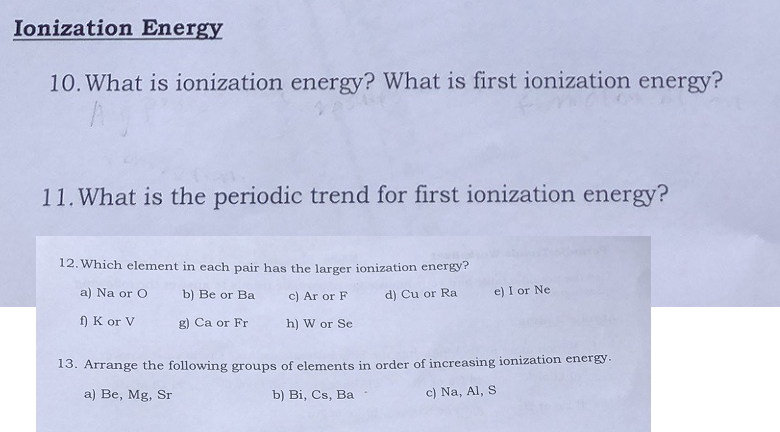Ionization, a fundamental process in atomic and molecular physics, occurs when an atom or molecule acquires a net electric charge by gaining or losing electrons. This phenomenon holds profound implications not only in the realm of chemistry but also in various applications across physics and biology. This discussion will delve into whether ionization conserves kinetic energy and elucidate the intriguing interrelationship between ionization energy and kinetic energy, all while offering a fresh perspective on an often-overlooked quantum question.
To begin with, let’s define ionization energy. It is the energy required to remove an electron from an isolated atom or molecule. This energy varies significantly between different elements, primarily influenced by their atomic structure and the influence of electron shielding and nuclear charge. The process of ionization results in the formation of ions, wherein positive ions are formed upon electron removal, whereas negative ions may form upon the addition of electrons. This duality in charge response lays the groundwork for comprehending the energetic dynamics at play during ionization.
The crux of the inquiry related to whether ionization conserves kinetic energy lies in the principles of energy conservation and transformation. According to the law of conservation of energy, energy cannot be created or destroyed; it can only be converted from one form to another. Thus, understanding how kinetic energy interacts with ionization requires a thorough examination of these energy transformations. When an electron is ejected from an atom, the remaining system, comprised of the atom and the emitted electron, undergoes a shift in energy states.
Upon ionization, the loss of an electron from an atom results in a transition in the overall energy distribution of the system. The freed electron carries away kinetic energy, which corresponds to the amount of energy supplied during the ionization process. This kinetic energy is not lost; rather, it is transformed and manifested in the motion of the emitted electron. The energy required to remove the electron, represented by the ionization energy, can sometimes be equal to or greater than the kinetic energy gained by the electron. This can lead to a misconception that kinetic energy is conserved during ionization.
To unravel this complexity, consider the quantum mechanical perspective. The behavior of electrons around an atom is governed by the intricate principles of quantum mechanics, where particles exhibit both wave-like and particle-like characteristics. When an atom undergoes ionization, the energy associated with the electron transitions from a bound state to a free state. This results in an increase in kinetic energy; however, it is crucial to recognize that this does not imply a strict conservation of kinetic energy in the traditional sense.
The electron’s kinetic energy post-ionization is intricately connected to the energy dynamics of the ionized atom itself, which experiences what can be described as a ‘rebound’ effect. The ion, now positively charged, repels the electron trying to escape. This interaction modifies the kinetic energy profile of the system. By acknowledging these complexities, one begins to appreciate the nuanced answers to whether kinetic energy is conserved during ionization: it is transformed and redistributed rather than preserved in its original form.
Further complexity arises when considering multi-electron atoms where electron-electron interactions come into play. The removal of one electron from such systems influences the kinetic energies of the remaining electrons. The energy’s redistribution encapsulates a broader understanding of the tightly woven dance of electrons within atoms. An ionized atom experiences alterations in both potential energy and kinetic energy dynamics, reshaping not just the state of the atom but also the properties of surrounding atoms and molecules.
This intricate ballet of energies leads to fascinating implications in various fields, including astrophysics, atmospheric science, and even environmental studies. For example, understanding ionization at a fundamental level is essential when investigating the ionosphere, where high-energy solar radiation ionizes atmospheric gases, leading to a series of interactions that can affect satellite communications and climate models.
Moreover, ionization plays a pivotal role in various technologies, from creating fluorescent lights to highly sensitive sensors used in environmental monitoring. The discernment of kinetic energy changes during ionization processes can improve the design of these systems, leading to more efficient and innovative technological applications.
In the grander context of climate science, recognizing the energetic interplay involving ionization might prompt a shift in perspective. It highlights the intricate connections between quantum phenomena and macroscopic outcomes such as atmospheric chemistry and climate dynamics. This relationship underscores the importance of interdisciplinary approaches in tackling pressing environmental issues. A comprehensive understanding of ionization and energy conservation could, for instance, enhance our methods for climate modeling, leading to better predictions of climate behavior in the face of global change.
In conclusion, ionization, a cornerstone of atomic behavior, does not simply act as a conduit for kinetic energy but rather as a transformative process that elucidates the interactions between energy forms in the quantum realm. The energy transformations involved in ionization beckon researchers and scientists to reevaluate classical interpretations of kinetic energy conservation within this context. The compelling narrative woven by these quantum questions serves not only to satiate intellectual curiosity but also to deepen our comprehension of the natural world and inform innovative solutions to urgent challenges in environmental sustainability.






